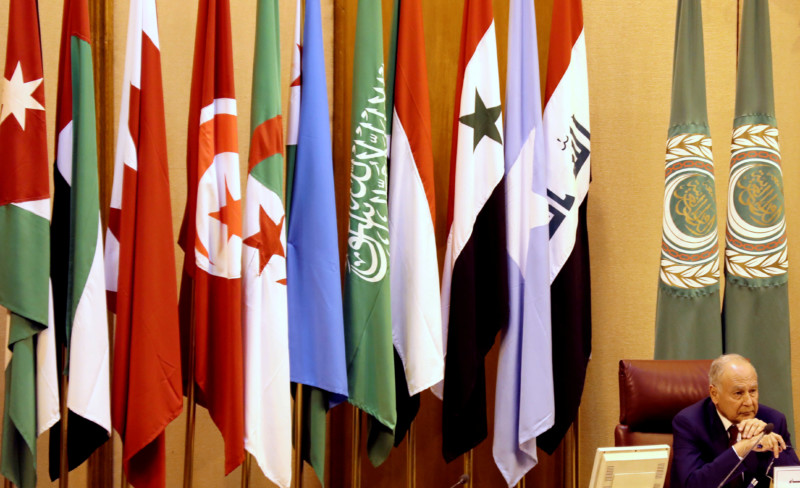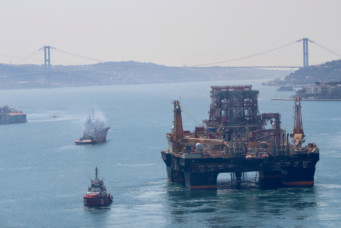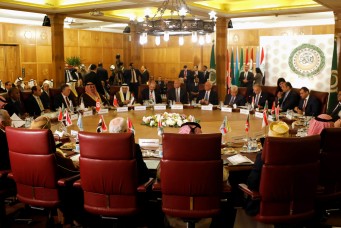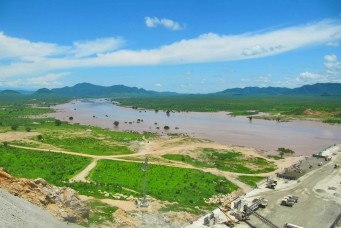Arab Nationalism, Regionalism, and Regional Integration
In the third decade of the 21st century, regionalism and regional integration in the Arab region stood in contrast with experiences in other regions of the world. Rather than facilitate integration, Arab nationalism seems to have in fact obstructed it

Flags of Arab states stand in the backdrop of an Arab Foreign Ministers meeting, Cairo, July 27, 2017. Mohamed Abd El Ghany/Reuters
Since the successive accession of Arab countries to independence and statehood starting in the 20th century, Arab unity has not ceased to be a subject of discussion, dreams, and disappointments. Debates about Arab unity are grounded in several factors that underpin and should facilitate them. Arabic is the common language of the very vast majority of inhabitants of the Arab states, which are situated in a geographical continuum in West Asia and North Africa and have been brought together in successive imperial formations between the 7th and 20th centuries. Ideologically, Arab nationalism articulated these basic tenets of unity, and was joined by the complementarity of natural and human resources in the Arab states in recent decades.
A century after the genesis of the Arab state system, the debates over bonds between Arab peoples and relations between Arab states have not abated, even though the perspective has changed. The debates are no longer about unity, but bear on the regionalism in which Arab states have been engaged since the 1940s. Participants in the debates lament that this regionalism has not at least resulted in Arab regional integration.
Regionalism and Arab Nationalism
For our purposes, two definitions for regionalism seem appropriate. In the first, regionalism is a policy and project whereby states and non-state actors cooperate and coordinate strategy within a given region. In the second definition, the strategy aims at building a type of world order, is associated with a formal program, and often leads to institution-building. Regionalism is considered to promote common goals and to aim at region-building, and at establishing regional coherence and identity.
The League of Arab States (LAS) is the foremost expression of regionalism in the Arab World. It is currently and overwhelmingly also considered the expression of the Arab World’s failure to achieve its common goals. It could not reach a satisfactory and just solution to the Palestinian question, which was its essential raison d’être for over seven decades. Nor could it achieve coordination, cooperation, or coherence in the actions of its members. To which extent are these diagnoses and verdicts true?
The ire, lamentation, and even sarcasm of observers and analysts from within and without the Arab World are aimed directly at the LAS Secretariat rather than the organization itself. This is unfair, regardless of the Secretariat’s actual and possible shortcomings. Though secretariats—specialized bureaus or offices, such as the International Labour Office within the International Labour Organization or the International Bureau of the Universal Postal Union (UPU) within the UPU itself, for example—were clearly distinguished from some international organizations established in the second half of the 19th century and first half of the 20th, this changed with the establishment of the United Nations in 1945, signifying a new generation of internationalization.
In fact, the LAS Secretariat’s weakness stems from the very charter of the organization. The Charter of the LAS is a simple document of a preamble and twenty articles. It does not compare with the 111 articles of the UN Charter, the 112 articles of the Charter of the Organization of American States or even the thirty-three articles of the Constitutive Act of the African Union adopted in 2000, fifty-five years after the LAS. The Charter of the LAS refers to the Secretariat’s composition, made up of the Secretary-General and other senior officials, in one article. In another, it identifies just one function for the Secretary-General, which is preparing the draft budget of the organization. This is a far cry from the UN Charter’s five articles on the Secretariat, and particularly from Article 99, which empowers the Secretary-General “to bring to the attention of the Security Council any matter which in his opinion may threaten the maintenance of international peace and security”. Therefore, the LAS Secretariat cannot be blamed for the failure of Arab regionalism.
Secretaries-General have tried to make up for the silence of the Charter on their functions and those of the Secretariat. For example, Secretary-General Amre Moussa assumed the functions attributed to the League’s Council by Article 5 in the Charter when he visited former Iraqi President Saddam Hussein and attempted to convince him to take an action that would forestall an American military intervention in his country. He even attempted a mediation in a political dispute internal to an LAS member state, Lebanon, a function totally unforeseen by the Charter. If under different Secretaries-General, and despite their efforts, the Secretariat did not achieve its goals, the fault must lie elsewhere.
The LAS attempted to build a regional order around it made up of organizations and specific norms, on par with those at the international level. It worked for the independence of Arab states, which were deprived of sovereignty when it was established in 1945. According to Marco Pinfari, professor at the American University in Cairo, a fair assessment of the regionalism promoted by the LAS cannot judge it as a total failure. For Pinfari, the picture is more complex than what is portrayed in a number of empirical studies, including one by this author. The LAS managed to settle, at least partially, a number of minor wars in the Arab region. Even in a potentially major dispute, it was able to preserve Kuwaiti independence acquired in 1961. Importantly, the LAS has also preserved the sense of an Arab identity.
Arab regionalism is not confined to the LAS. Movements of labor migration between Arab states, the mixed production and consumption of cultural goods over the entire region, inter-Arab tourism, bilateral financial assistance, and investments are further expressions of Arab regionalism. Nevertheless, the assumed failure of the LAS to embody Arab regionalism must be taken seriously. Perceptions command understanding and action.
The establishment of the LAS highlighted a chasm between two strains of thought: Arab nationalism and nascent Arab regionalism. Arab nationalism espoused that Arabs were one nation and as such they should be united in one state. For them, the LAS was a colonial enterprise meant to keep the Arab states disunited. Indeed, the drafters of the Charter confirmed the misgivings of the nationalists. In Article 2, they declared that the League’s purpose was “the reinforcement of links between member states and the coordination of their political plans with a view to realizing their cooperation and preserving their independence and sovereignty”. In one report, the foreign minister of a member state in the late 1940s or early 1950s said to the militant first Secretary-General Abdel Rahman Azzam: this is “the League of Arab States, not the Arab League”.
Arab nationalist thought affected the entire regional environment that encompassed the LAS, its specialized agencies, and first and foremost the Arab states themselves. It implicitly cast doubt upon the legitimacy of distinct Arab states, especially in certain sub-regions such as Greater Syria where Arab nationalist thought originated. Arab states were nation states, logically unacceptable for advocates of the Pan-Arab nation. Nationalism also implicitly meant that Arabs of one state had a legitimate say in what happened in other Arab states, which naturally suggests that it also creates claims for Arabs to the resources of all Arab states.
The tension between the nationalist perspective and the interests of constituted Arab nation states to protect their sovereignty and prerogatives precluded sustained progress in regionalism as an intergovernmental process, even when attempts to reinforce it were made. The problem was not with the LAS as an embodiment of regionalism in the Arab World. It was in the tension between two concepts of common Arab action. The higher and most encompassing Arab nationalism concept kept the lower regionalism one from developing. For nation states, common action could develop into Arab nationalism, which was not acceptable for a good number of them. Moreover, the same advocates of Arab nationalism were fiercely divided for much of the past several decades. (No judgment is made here on the merits of Arab nationalism and regionalism). It is only observed that neither could override the other. Furthermore, the legitimacy of Arab nation states is reinforced by the fact that the international and regional systems are those of nation states. Whether in Europe, Africa, South America, or Southeast Asia, despite the frequent inadequacy of the concept, nation states, fully recognized as legitimate, are the foundation of processes that further regionalism to higher levels of regional integration.
Regional Integration: The Past and the Future
Regional integration is the most advanced form of interstate cooperation at the regional level. Writing about the European experience, political scientist Ernst Haas, who has primarily theorized neofunctionalism (a theory of regional integration), provides the most authoritative definition of regional integration as “the process whereby political actors in several distinct national settings are persuaded to shift their loyalties, expectations, and political activities to a new center, whose institutions possess or demand jurisdiction over preexisting national states”. The end result, according to Haas, is a “new political community, superimposed over the preexisting ones”. In fact, regional integration is a process establishing one legitimate decision-making system that produces policies that are binding for participating states. Economic and sectoral policies are the first areas of regional integration.
Arab states were not unaware of the value of cooperation for their economic growth and development. Their earliest cooperation came in the form of a joint defense against the newly established state of Israel. Thus, they adopted the Treaty on Joint Defense and Economic Cooperation in 1950, the same year the process of European integration was launched. In 1962, they adopted the Agreement on Arab Economic Unity and in 1964, by a resolution of the Council of Arab Economic Unity, they established the Arab Common Market Agreement. The latter was a misnomer since the resolution was only about the establishment of a free trade area. Still focused on trade in their cooperation, after another iteration, Arab states ended up adopting the Agreement on the Establishment of the Great Arab Free Trade Area (GAFTA) in 1997. GAFTA has advanced more than its predecessors. However, the last seventy years have far from realized a cooperation that reinforces the development of Arab states, not to speak of their integration.
Across the globe, regional integration has played out in different manners. The first stages of European integration proceeded in accordance with a neofunctional dynamic, which was driven by exchange of benefits, package deals, and spillover processes. Some states drew benefits in one policy area while others reaped them in others. Therefore, decisions were made as a package so that states could be confident about the exchange of benefits. Integrated policies in some areas commanded that integration spill over to others. Later on, European integration also proceeded as an intergovernmental, in addition to neofunctional, process. Whereas in the neofunctional dynamic the spillover in integration areas was decided by organs of the regional integration institution in accordance with its governing document, in intergovernmental processes, every new step required a novel international treaty. In West Africa and South America, different doses of neofunctional and intergovernmental processes steered integration with the intergovernmental approach dominating. In Southeast Asia, following the so-called ASEAN way (referring to the Association of Southeast Asian Nations) of prolonged discussions, consensus, and slow progress based on the least common denominator, the process was exclusively intergovernmental. Even if it took time, this did not impede tangible progress in Southeast Asian integration.
Regional integration in the Arab World cannot measure up to any of the regional and subregional processes referred to above. Several political and economic factors may explain its poor performance. Even if it is in economic and sectoral policy areas, regional integration is a political process. Establishing one integrated decision-making system, which implies giving up exclusive sovereignty, is in the essence of politics. For states having recently grasped sovereignty, giving it up is a far cry. Furthermore, Arab states also have relatively simple and similar economic production structures. In regional integration processes centered on trade, varied, complex, and diversified production structures exchange goods and services and expand their markets to the benefit of all parties. There is nothing much on which the integration can bear when economies produce few and similar goods. More advanced integration processes provide for the freedom of movement of capital and labor.
In the case of the Arab World, disparity in capital and labor endowments, rather than promoting complementarity, further impedes it. A comparatively rich country (such as Saudi Arabia or the UAE) may not find lucrative investment opportunities in a little-developed economy with low per capita income and weak purchasing power. The same capital-rich state, sparsely populated, does not have reason to open its labor market to workers from large-population, labor surplus states which may flood it. For its authorities, the repercussions of such openings would be political and economic. Politically, Arab nationalist claims may result in competition with nationals of the rich state for the privileges they enjoy. By the same token, they may undermine the governing arrangements of the rich state. Economically, for rich states, unchecked access of workers from labor surplus states (such as Egypt or Yemen) at all skill levels to their labor markets might create problems of unemployment and underemployment and depress wages. Not recognizing that national and migrant workers are active in separate segments of their labor markets, they consider the latter responsible for the employment challenges they face. Therefore, freedom of movement of labor could not be envisaged by rich states. In any case, the large international supply of migrant labor allows them to secure the workers they need.
Advancing Integration
Purely identitive considerations and unsubstantiated claims of a common destiny for all Arabs have advanced neither unity nor integration in the past. They are not likely to have success in advancing them in the future. The political and economic challenges that stood in the way of effective integration in the last several decades need to be recognized. This would also mean the unquestioned recognition of the legitimacy and sovereignty of Arab states, and separately, of their national interests, which may not fully converge with one another. In the logic of the international interstate system, interests and security are those of each nation state, not those of a group. It is only after recognizing each others’ sovereignty that states can start efforts toward giving up exclusive rights to certain functions, with the expectation of realizing commensurate benefits that reinforce the legitimacy of each state. This would pertain to certain policy areas. The integrating states would jointly exercise parts of their sovereignties that they had given up. Dismantling the exclusive rights to exercise parts of sovereignty and jointly exercising those parts is the process of achieving regional integration.
The key is to identify sectors of activity where integrating states can exchange benefits. Trade can be kept as a sector of cooperation under the GAFTA agreement, but it should not be relied upon to achieve integration for the reasons briefly discussed above. Sectors that combine production and exchange should be identified. Moreover, not all Arab states must necessarily engage in the integration process from the start. This means that regionalism as expressed in a reformed LAS, or a new interstate organization, and in regional civil society, would subsist alongside the integration scheme. In Africa, the Americas, and Europe, interstate organizations exist alongside regional and subregional integration schemes.
Because of the challenges they represent, the potential they hold, and the relationship between them, the water and renewable energy sectors are prime candidates for launching the integration scheme. Water scarcity is common in the Arab World. Eighteen out of the twenty-two Arab countries are suffering from severe water shortages, and ten of them face “extremely high” water stress due to increasing demand, as 2019 data from the World Resources Institute shows. According to the International Renewable Energy Agency (IRENA), the Arab region’s renewable energy potential is high, particularly for wind and solar projects. Most Arab states are part of the Sun Belt and benefit from solar insolation levels that are among the highest in the world (the country-level Sun Belt regions are the tropical climate countries, according to Köppen climate classification). Hydroelectric power is energy produced by water, and energy is used to desalinate and treat used water. Several Arab states can draw significant potential from their cooperation in and integration of their water and renewable energy sectors.
Environmental policy is a third policy area where integration could spill over. Given its obvious relationship to water and energy, it can also be integrated from the start. Interested states can declare their intention to integrate and identify the sectors to be integrated. Technical experts can support them by addressing the scientific and technical challenges of the common action.
From a political perspective, the challenges facing integration are different. They are first about managing the progressive renunciation of the exclusive exercise of sovereignty in the integrated sectors. Second and most importantly, they are about the management of the pool of shared sovereignty, and third, about sharing in the costs and benefits of the integrated sectors’ outputs. All these challenges revolve around the integration scheme’s institutions and its decision-making. The establishment of a strong executive that is the engine of integration, comparable to the European Union’s Commission, and the progress in integration following the spillover rationale may be the most effective. But an intergovernmental approach, where governments take the lead and treaties are signed for every new integration stage, can also be envisaged.
What is important is that the decisions, jointly made, should be binding. The promised and well-assessed benefits of integration are the best guarantees for decisions to be complied with. In making the decisions, population and gross domestic product, reflected in the financing of the scheme, should be taken into account in the distribution of votes so as to encourage larger and richer states to participate in the scheme. A threshold for the adoption of decisions should protect smaller states from being overridden by the larger ones. In other words, the threshold should ensure that a coalition of small states forestalls the adoption of decisions that major states with large numbers of votes alone want. Whether in a neofunctional or intergovernmental approach, the package deal rationale based on the exchange of benefits is essential in maintaining and advancing the integration process.
An essay such as this can only flag the issues to be addressed in establishing and managing an integration process. Negotiators for concerned states should analyze and address these and others in a spirit aimed at making the projected process a successful reality. They may also envisage the spillover of the process into other sectors of activity. Negotiators may finally discuss the degree of openness of the process, which allows, after some conditions are met, to connect to other states in the vicinity or neighborhood of the Arab World. The Middle East, subregions in Africa (other than North Africa), and Europe are the most obvious candidates for expanding the Arab integration scheme.
Ibrahim Awad is professor of practice of global affairs and the director of the Center for Migration and Refugee Studies in the School of Global Affairs and Public Policy at the American University in Cairo. From 2005 to 2010, he acted as director of the International Migration Programme at the International Labour Organization (ILO), Geneva, and prior to that, between 2005 and 2010, he was the ILO’s director for the North Africa sub-regional office. His most recent publications include “The Challenge of Global Governance in the Sustainable Development Agenda,” “The Multiple Levels of Governance of International Migration:Understanding Disparities and Disorder,” and “Towards a Joint Approach to Migration and Asylum in the Euro-Mediterranean Space,” to name a few.
Read MoreSubscribe to Our Newsletter





